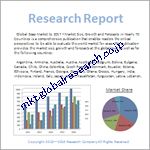目次
第1章.地盤工学の世界市場 エグゼクティブサマリー
1.1.地盤工学の世界市場規模・予測(2022~2032年)
1.2.地域別概要
1.3.セグメント別概要
1.3.1.タイプ別
1.3.2.用途別
1.4.主要トレンド
1.5.不況の影響
1.6.アナリストの提言と結論
第2章.世界の地盤工学市場の定義と調査前提
2.1.調査目的
2.2.市場の定義
2.3.調査の前提
2.3.1.包含と除外
2.3.2.限界
2.3.3.供給サイドの分析
2.3.3.1.入手可能性
2.3.3.2.インフラ
2.3.3.3.規制環境
2.3.3.4.市場競争
2.3.3.5.経済性(消費者の視点)
2.3.4.需要サイド分析
2.3.4.1.規制の枠組み
2.3.4.2.技術の進歩
2.3.4.3.環境への配慮
2.3.4.4.消費者の意識と受容
2.4.推定方法
2.5.調査対象年
– 歴史的年:2022年
– 基準年: 2023
– 予測期間: 2024年から2032年
2.6.通貨換算レート
第3章.地盤工学の世界市場ダイナミクス
3.1.市場促進要因
3.1.1.都市化の進展とインフラ整備
3.1.2.地下調査技術の進歩
3.1.3.持続可能な建設に対する政府の投資
3.2.市場の課題
3.2.1.多様な土壌組成と地質学的不確実性
3.2.2.変動する原材料コスト
3.2.3.厳しい規制の枠組み
3.3.市場機会
3.3.1.デジタル・モデリングと予測分析における革新
3.3.2.新興市場での拡大
3.3.3.環境に優しく持続可能な実践の統合
第4章.世界の地盤工学市場の産業分析
4.1.ポーターの5フォースモデル
4.1.1.サプライヤーの交渉力
4.1.2.バイヤーの交渉力
4.1.3.新規参入者の脅威
4.1.4.代替品の脅威
4.1.5.競合他社との競争
4.1.6.ポーターの5フォースモデルへの未来的アプローチ
4.1.7.ポーター5フォースのインパクト分析
4.2.PESTEL分析
4.2.1.政治的
4.2.2.経済的
4.2.3.社会的
4.2.4.技術的
4.2.5.環境
4.2.6.法律
4.3.主な投資機会
4.4.トップ勝ち組戦略
4.5.破壊的トレンド
4.6.業界専門家の視点
4.7.アナリストの推奨と結論
第5章.地盤工学の世界市場規模・タイプ別予測(2022〜2032年)
5.1.セグメントダッシュボード
5.2.地盤工学の世界市場タイプ別収益動向分析、2022年・2032年 (百万米ドル/億ドル)
5.2.1.地下都市空間エンジニアリング
5.2.2.斜面・掘削エンジニアリング
5.2.3.地盤・基礎工学
第6章.地盤工学の世界市場規模・用途別予測(2022〜2032年)
6.1.セグメントダッシュボード
6.2.地盤工学の世界市場アプリケーション別収益動向分析、2022年・2032年 (百万米ドル/億ドル)
6.2.1.都市工学
6.2.2.水工学
6.2.3.橋梁・トンネル工学
6.2.4.鉱山工学
6.2.5.建築工学
6.2.6.その他
第7章.地盤工学の世界地域別市場規模・予測(2022〜2032年)
7.1.北米の地盤工学市場
7.1.1.米国の地盤工学市場
7.1.1.1.タイプ別内訳規模と予測、2022~2032年
7.1.1.2.用途別内訳規模・予測、2022~2032年
7.1.2.カナダの地盤工学市場
7.2.ヨーロッパの地盤工学市場
7.2.1.イギリスの地盤工学市場
7.2.2.ドイツの地盤工学市場
7.2.3.フランスの地盤工学市場
7.2.4.スペインの地盤工学市場
7.2.5.イタリアの地盤工学市場
7.2.6.その他のヨーロッパの地盤工学市場
7.3.アジア太平洋地域の地盤工学市場
7.3.1.中国の地盤工学市場
7.3.2.インドの地盤工学市場
7.3.3.日本の地盤工学市場
7.3.4.オーストラリアの地盤工学市場
7.3.5.韓国の地盤工学市場
7.3.6.その他のアジア太平洋地域の地盤工学市場
7.4.中南米の地盤工学市場
7.4.1.ブラジルの地盤工学市場
7.4.2.メキシコの地盤工学市場
7.4.3.その他のラテンアメリカの地盤工学市場
7.5.中東・アフリカの地盤工学市場
7.5.1.サウジアラビアの地盤工学市場
7.5.2.南アフリカの地盤工学市場
7.5.3.その他の中東・アフリカ地盤工学市場
第8章.競合他社の動向
8.1.主要企業のSWOT分析
8.1.1.企業1
8.1.2.企業2
8.1.3.会社3
8.2.トップ市場戦略
8.3.企業プロフィール
8.3.1.企業1
8.3.1.1.主要情報
8.3.1.2.概要
8.3.1.3.財務(データの入手可能性による)
8.3.1.4.製品概要
8.3.1.5.市場戦略
8.3.2.企業2
8.3.3.会社3
8.3.4.4社目
8.3.5.5社
8.3.6.6社
8.3.7.7社
8.3.8.8社
8.3.9.9社
8.3.10.10社
第9章.研究プロセス
9.1.研究プロセス
9.1.1.データマイニング
9.1.2.分析
9.1.3.市場推定
9.1.4.バリデーション
9.1.5.出版
9.2.研究属性
表一覧
表1.地盤工学の世界市場 – レポートスコープ
表2.地盤工学の世界市場 – 2022〜2032年地域別推定・予測(百万米ドル/億ドル)
表3.地盤工学の世界市場 – 2022〜2032年タイプ別推定・予測 (百万米ドル/億ドル)
表4.地盤工学の世界市場 – 用途別推計・予測 2022-2032 (百万米ドル/億米ドル)
表5.地盤工学の世界市場 – セグメント別推計および予測、2022-2032年 (百万米ドル/億米ドル)
表6.北米の地盤工学市場の見積もりと予測、2022-2032年 (百万米ドル/億ドル)
表7.米国の地盤工学市場のセグメント別見積もりと予測、2022~2032年 (百万米ドル/億ドル)
表8.カナダの地盤工学市場の見積もりと予測、2022~2032年 (百万米ドル/億ドル)
表9.ヨーロッパの地盤工学市場の国別見積もりと予測、2022-2032 (百万米ドル/億ドル)
表10.アジア太平洋地域の地盤工学市場の見積もりと予測、2022~2032年 (百万米ドル/億ドル)
表11.ラテンアメリカの地盤工学市場の見積もりと予測、2022-2032年 (百万米ドル/億ドル)
表12.中東・アフリカの地盤工学市場の見積もりと予測、2022-2032年 (百万米ドル/億ドル)
図表一覧
図 1.地盤工学の世界市場 – 調査手法
図2.地盤工学の世界市場 – 市場推定手法
図3.地盤工学の世界市場 – 市場規模予測・予測手法
図4.地盤工学の世界市場-主要動向2023年
図5.地盤工学の世界市場 – 成長見通し2022年~2032年
図6.地盤工学の世界市場 – ポーターの5フォースモデル
図7.地盤工学の世界市場 – PESTEL分析
図8.地盤工学の世界市場 – バリューチェーン分析
図9. 地盤工学の世界市場 – 2022年および2032年のセグメント別内訳(百万米ドル/億ドル)
図 10.北米の地盤工学市場、2022年および2032年(百万米ドル/億米ドル)
図 11.ヨーロッパの地盤工学市場、2022年および2032年(百万米ドル/億米ドル)
図12.アジア太平洋地域の地盤工学市場、2022年~2032年(百万米ドル/億米ドル)
図13.ラテンアメリカの地盤工学市場、2022年~2032年(百万米ドル/億米ドル)
図14.中東・アフリカの地盤工学市場、2022年~2032年(百万米ドル/億米ドル)
図15.地盤工学の世界市場 – 企業市場シェア分析(2023年)
このリストは完全なものではなく、最終報告書にはさらに図表が含まれています。リストは最終成果物で更新される可能性があります。
The geotechnical engineering sector is undergoing a transformative phase, driven by innovations in materials science and geotechnical analysis software. The use of high-resolution geospatial data, combined with predictive modeling and simulation tools, has significantly enhanced the accuracy of subsurface assessments. These advancements enable engineers to anticipate and mitigate potential issues, reducing costs and improving project timelines. Moreover, governments and private entities are investing heavily in infrastructure renewal and expansion, fueling the demand for skilled geotechnical expertise. With large-scale urban infrastructure projects on the rise, the need for cutting-edge geotechnical solutions is greater than ever, paving the way for sustainable urban growth and development.
Despite its promising trajectory, the market is not without its challenges. The complexities involved in analyzing variable soil compositions, coupled with fluctuating raw material costs, can lead to increased project expenses and longer timelines. Regulatory frameworks surrounding construction safety and environmental impact also present hurdles that require careful navigation. Nevertheless, these challenges have prompted the geotechnical engineering community to adopt more robust risk assessment tools and innovative project management strategies. By leveraging collaborative approaches and state-of-the-art technologies, industry players are steadily overcoming these obstacles, ensuring the continued growth and advancement of geotechnical solutions.
In the regional landscape, North America continues to lead the geotechnical engineering market, bolstered by stringent safety regulations and robust infrastructure spending. The region’s commitment to maintaining and upgrading critical infrastructure supports steady market growth. Meanwhile, Asia Pacific is poised to witness the fastest expansion, driven by rapid urbanization, industrialization, and government investments in large-scale infrastructure projects. Europe remains a key player, with its emphasis on sustainable construction practices and innovative engineering techniques, while Latin America and the Middle East & Africa present emerging opportunities fueled by increased infrastructure development efforts.
Major market player included in this report are:
1. Fugro N.V.
2. KELLER
3. Bauer AG
4. Arcadis N.V.
5. AECOM
6. Jacobs Engineering Group Inc.
7. Tetra Tech, Inc.
8. Atkins (SNC-Lavalin Group)
9. Stantec Inc.
10. Kiewit Corporation
11. COWI A/S
12. Golder Associates (WSP)
13. EGS (International) Ltd
14. Amec Foster Wheeler (John Wood Group)
15. Arup Group
The detailed segments and sub-segment of the market are explained below:
By Type
• Underground City Space Engineering
• Slope and Excavation Engineering
• Ground and Foundation Engineering
By Application
• Municipal Engineering
• Hydraulic Engineering
• Bridge and Tunnel Engineering
• Mining Engineering
• Building Construction
• Others
By Region:
North America:
• U.S.
• Canada
Europe:
• UK
• Germany
• France
• Spain
• Italy
• ROE
Asia Pacific:
• China
• India
• Japan
• Australia
• South Korea
• RoAPAC
Latin America:
• Brazil
• Mexico
Middle East & Africa:
• Saudi Arabia
• South Africa
• RoMEA
Years Considered for the Study:
• Historical Year: 2022
• Base Year: 2023
• Forecast Period: 2024 to 2032
Key Takeaways:
• Market estimates & forecasts spanning a decade (2022-2032)
• Annualized revenue analysis and regional-level assessments for each market segment
• Comprehensive country-level analysis across major geographic regions
• In-depth competitive landscape profiling, detailing key market players and their strategic developments
• Expert business recommendations and insights into the competitive structure
• Demand-side and supply-side analysis to determine market growth dynamics
❖ 免責事項 ❖
http://www.globalresearch.jp/disclaimer

